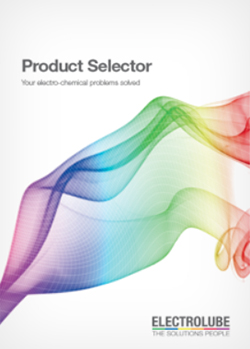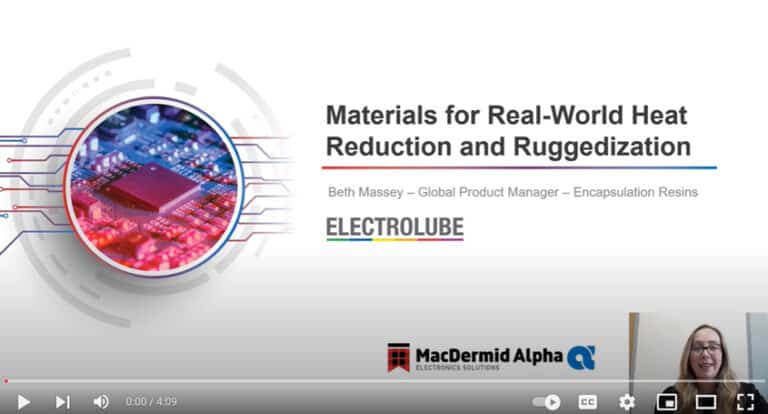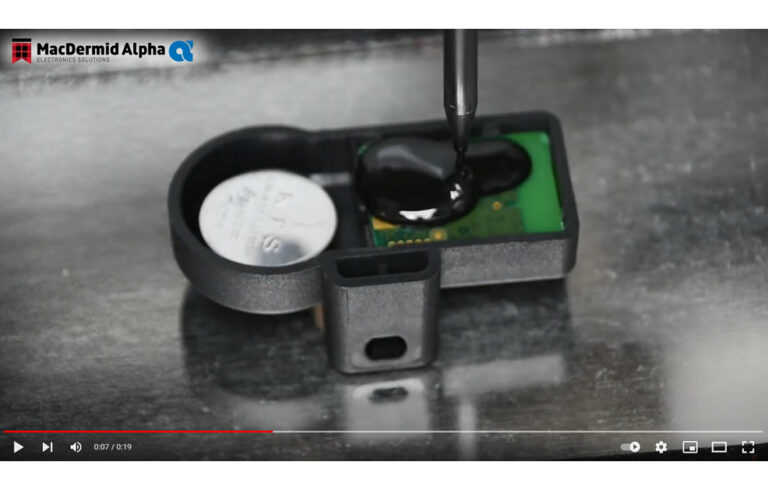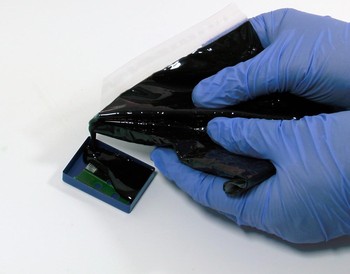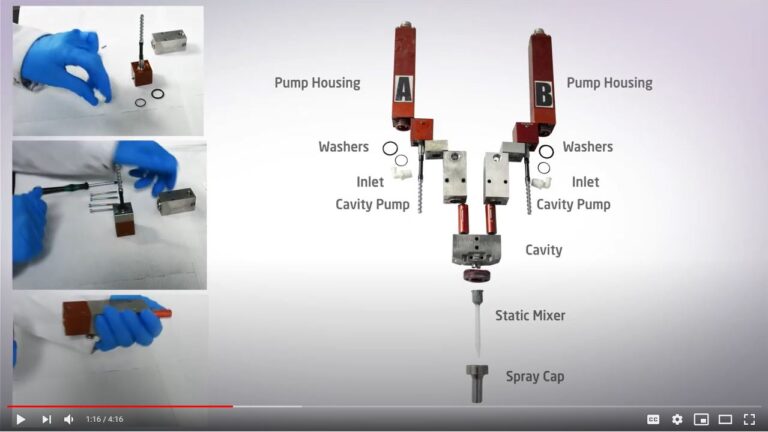What Are Conformal Coatings?
A conformal coating is a thin polymeric film applied to a printed circuit board (PCB) in order to protect the board and its components from the environment and corrosion. The film is typically applied at 25-250µm and ‘conforms’ to the shape of the board and its components, covering and protecting solder joints, the leads of electronic components, exposed traces, and other metallised areas from corrosion, ultimately extending the working life of the PCB.
Why do I need a Conformal Coating?
A newly manufactured printed circuit board will generally perform well, but performance can quickly deteriorate due to external factors in its operating environment. Conformal coatings can be used in a wide range of environments to protect printed circuit boards from moisture, salt spray, chemicals and temperature extremes in order to prevent such things as corrosion, mould growth and electrical failures. The protection provided by conformal coatings allows for higher voltage gradients and closer track spacing, in turn enabling designers to meet the demands of miniaturisation and reliability.
Which industry requires Conformal Coatings?
The use of conformal coatings is particularly important in automotive, military, aerospace, marine, lighting, industrial and green energy applications. However due to the rapid expansion of the electronics industry, conformal coatings are also finding their way into the domestic and mobile electronics industries, providing the necessary combination of high performance and reliability within a vast array of electronic devices.
Conformal Coating Selection and Best Practice:
Whilst it is tempting to choose your coating based on cost factors, it is important to remember that to achieve the right level of protection from your coating material you will need to carefully select the right material for your application. Different types of coating will perform better in different operating environments, therfore selecting the best coating for your application is paramount to achieving the levels of protection you require. We have provided the basis for you to make your selection here, however our unrivalled technical support team are always on hand to answer any queries you may have and to assist you in selecting the right material.
Conformal Coating Types
Coatings can be categorised by their base chemistry, each option having its own beneficial properties for the different environments the PCB will be operating in. The most widely used materials are historically solvent-based, the benefits of which include:
- Ease of processing and application
- Simple viscosity adjustment
- Suitability for a range of application methods
- Tailored application and cure
Acrylic Coatings
Acrylics combine reasonable price with good environmental protection; they retain clarity and can resist darkening and hydrolysis during extended exterior exposure. They do however have a limited solvent resistance, making them suitable for re-work but not applications where chemical resistance is important.
- Acrylic coatings offer good flexibility and all round protection
- They offer excellent humidity and salt mist protection
- They are easy to apply and remove and dry quickly at room temperature via simple solvent evaporation
- They have a wide operating temperature range.
- They have excellent adhesion to a wide variety of substrates
Polyurethane Coating
In contrast to acrylics, polyurethane coatings offer excellent chemical resistance and superior protection in harsh environments. They also maintain flexibility at very low temperatures. Like acrylics, they are also very versatile covering a broad operating temperature range.
- Good flexibility, particularly at low temperatures
- Excellent chemical resistance
- Polyurethane coatings can be removed using specialist products (CCRG)
- Very good abrasion resistance
Hybrid Coatings
Hybrid coatings are where a mixture of base chemistries are used. These can result in a number of different coating options, tailoring the requirements for specific applications.
Electrolube’s SCC3 range of conformal coatings are polyurethane base resins modified with silicone to enhance the high temperature properties of the resin. These coatings display a wide range of advantages over standard materials and as they are solvent-based, they also provide all the benefits of ease of application. The SCC3 range of coatings offers a wide range of performance benefits without the problems associated with standard silicone coatings; i.e. silicone migration and the effects of low molecular weight siloxanes.
- Extremely wide operating temperature range
- Easy to apply
- Very high chemical resistance
- Can be reworked with specialist coating removers (CCRG)
- Good protection in a wide range of environments
Silicone Coatings
Generally speaking silicones are the most resistant coatings to high/low temperatures or temperature fluctuations due to their more flexible nature. Electrolube also provide other modified silicone technologies which have been specifically designed for the railway industry. These coatings offer a wide range of protection in a both challenging and rapidly changing environments.
- Good all round protection
- Flexible
- wide operating temperature ranges
- Approved to IEC 61086
- Ease of processing and ideal for those applications requiring rework
Water-Based Coating
Water based coatings cure by evaporation of water from the system. They are low-VOC options, replacing the majority of solvent in the system with water. This improves operator safety and also dramatically reduces solvent emissions.
- Reduces solvent use; improves operator and environmental safety
- Electrolube products are NMP free; again offering a safer product
- Electrolube products are hybrid products offering enhanced performance
- Can be applied using standard equipment; dipping and spray versions available
- Can offer a good level of chemical resistance
UV Cure Coating
UV cure conformal coatings are also another example of hybrid coatings. In this case, different chemistry types are often used to produce a dual-cure system, thus avoiding issues with areas shadowed from the UV light during curing. UV cure coatings offer the fastest curing times with coatings curing in seconds under UV light. This is extremely beneficial for high throughput applications and any shadowed areas will cure via the secondary cure system over time. Due to their highly cross-linked structure when cured, they can be difficult to remove and in some cases UV cure coatings are known to suffer from reduced flexibility during thermal changes and therefore must be carefully tested.
- Extremely fast process times
- Secondary moisture cure system used to help shadow areas cure
- Good protection in a range of environments
- Excellent chemical resistance
2K Coatings
2K two part coatings are hybrid technologies combining the best properties of encapsulation resins with those of a conformal coating. These materials offer some of the best protection available while maintaining the processability and cost effectiveness of a conformal coating (compared to a resin).
- High Performance
- High levels of protection in a range of environments
- Applied more thickly than single part coatings
- Excellent moisture protection
How Do I Apply a Conformal Coating?
The application method of a conformal coating is AS important, if not MORE important than the selection of the right material for your application. This is because even the best coating, when applied poorly will not provide the right levels of protection required.
To read more about this, please refer to our blog ‘How to Apply Conformal Coating‘ or watch the video below.
How do I Cure a Conformal Coating?
Heat Cure Coating / Evaporation Cure Coating
Solvent based coatings cure by evaporation of solvents, this process can be accelerated in most cases by using heat, however this can affect the properties of the coating and cause coating defects if not performed correctly. In the case of Electrolube’s DCA for example, if you heat cure you get additional chemical resistance and greatly improved properties. Without heat cure, it offers good humidity protection. AFA, a non cross-linking solvent-based acrylic on the other hand, will reach the same protective capability regardless of the curing conditions, the use of heat just accelerates the process.
UV Cure Conformal Coating
UV curing uses intense ultraviolet light to set off a chemical reaction within the coating in order to cure almost immediately in areas exposed to the UV radiation. Due to the 3-D nature of most assemblies there will nearly always be areas that remain unexposed to the UV radiation (e.g. beneath components) and therefore a secondary cure mechanism is required. Moisture is the most common secondary initiation process since it does not require an additional process step, however formulations are available that use heat, although the cure times are relatively long (30 mins or more), and the temperatures are quite high (>120°C) which places additional thermal fatigue on the assembly.
Electrolube also offer UV cure coatings such as UVCLP and UVCLX which have a reliable chemical cure mechanism as the secondary process. This is considerably faster than the industry standard, with a full cure guaranteed in just 6-12 hours compared to up to two weeks or more with some products.
UV curing materials are popular in high throughput environments, since in most cases the parts can continue through the process within seconds of the curing process, thus speeding up manufacturing velocity and reducing Work In Progress (WIP).
Moisture Cure Coatings
Moisture cure coatings require moisture from the atmosphere to cure. The humidity in the atmosphere can affect the speed of cure; increasing the humidity will often speed up the process. Humidifiers can be added to conventional and IR ovens to provide greater humidity and accelerate this process. It is important that these products are handled with care. If containers are left open for long periods of time then moisture will be absorbed and the coating will begin to cure.
In the case of dip coating a dry argon blanket can be passed over the surface of the tank to ensure that the coating is kept dry whilst processing
Conformal Coating Standards
Conformal coating standards are a series of specifications and tests which a coating must pass in order to be considered for use in certain environments such as Military or Automotive applications.
Most conformal coatings are either qualified to MIL-I-46058C or meet the requirements of the closely related IPC-CC-830B specification. In addition they may be recognised by Underwriters Laboratories, either as a permanent coating, in which case the flammability of the coating is assessed to UL94V0, or as a conformal coating, where the electrical properties will be assessed as part of the UL746E standard.
These tests all require flat coupons to be coated with the conformal coating in question and are subjected to a variety of temperature and humidity conditions to assess the material’s properties. Whilst perfectly acceptable to assess the potential performance of the material, the actual protective capability of the coating in the end use environment is of greater concern to the user. The rest of this article will be devoted to understanding the issues that relate to end use performance in potentially corrosive environments.
MIL-I-46058C
Military Insulating Compound this is a common standard used throughout the industry for conformal coating materials. While it has been inactive for new designs since 1998, it is still a standard often required by military contractors. The main advantage of MIL-I-46058C is that it requires independent testing by a MIL approved laboratory (although at least one conformal coating manufacturer is an approved test laboratory so not completely independent!) and the military maintains a Qualified Product List (QPL) drawn from successful independent test reports.
Def Stan 59/47
The UK Ministry of Defence standard similar to the MIL-I-46058C this is a standard used by the British military for coatings used in high end electronics.
IEC 61086
International Electrotechnical Commission. Whilst similar in requirements to MIL-I-46058C, this standard is based on supplier self-certification. Of course, an independent test laboratory can be used, but the IEC does not maintain a QPL.
IPC-CC-830B
IPC-CC-830B is closely related to MIL-I-46058C and was introduced to provide an alternative to the MIL spec when it was declared inactive. CC-830 is an active specification and is continually being updated. Once again, there is no requirement to use an independent test laboratory, and there is no QPL maintained for this specification. Materials qualified to MIL-I-46058C are automatically deemed to meet the requirements of IPC-CC-830B.
UL94V0
UL94 relates to the flammability or self-extinguishing nature of the conformal coating on an FR4 substrate. V-0 is the highest classification that can be achieved, with other categories such as V-1 and V-2 denoting materials that burn for longer durations.
UL746E
UL746E is composed of a series of dielectric breakdown evaluations in addition to the UL94 flammability testing, and is intended to denote products that can be safely used on products that are required to meet UL safety standards. By documenting the use of UL recognised materials throughout the design, manufacturers can avoid the requirement to test their device to the applicable UL safety standards.
Environmental Standards
Here at Electrolube we believe that it is everyone’s responsibility, both individually, and as a business look after the world in which we all inhabit. Our R&D team are always looking at ways to minimise our environmental impact and we have several groundbreaking products as a result.
Policy:- Environmental Policy
VOCs – The Need for Change
Volatile solvents used in conformal coatings are classed as VOCs (Volatile Organic Compounds).
VOCs contribute towards the formulation of ground level ozone.
Such pollution can have many detrimental effects on the environment, damaging forests and vegetation.
In addition, some materials classed as VOCs can act as irritants and over exposure can lead to a variety of health problems.
VOC Definitions:
EPA
‘Volatile Organic Compounds (VOC) means any compound of carbon, excluding carbon monoxide, carbon dioxide, carbonic acid, metallic carbides or carbonates and ammonium carbonate, which participates in atmospheric photochemical reactions.’
EU Solvents Emissions Directive
‘Any organic compound with a boiling point less than or equal to 250˚C at a standard pressure of 101.3 kPa.’
Previously the directive referred to the definition as ‘Any organic compound, having at 20˚C a vapour pressure of 0.01KPa or more, or having corresponding volatility under the particular conditions of use’.
As stated on the European Commission website, either method is suitable:
The ‘boiling point approach’ was adopted for Directive 2004/42/CE because during negotiations Member States were generally more in favour of this definition of VOCs than the ‘vapour pressure approach’ definition in Directive 1999/13/EC. The main reason is that the boiling point of a substance is easier to identify (and presumably more data are available) than the vapour pressure at room temperature of the same substance. Nevertheless, the results of the two approaches for any one substance are, to the knowledge of the EU Commission, in most cases identical.’
Low VOC Alternatives
Products such as the Electrolube water-based coatings help to keep VOC levels to an absolute minimum without compromising on performance:
WBP ” Utilising hybrid technology, WBP offers the performance characteristics of a polyurethane coating, exhibiting excellent flexibility and solvent resistance. WBP is for dipping application methods.
WBPs – Is based on the same chemistry as WBP but specifically designed for spraying applications.
UVCL” utilises hybrid technology to provide extremely fast curing under suitable UV radiation. UVCL provides excellent protection under a wide range of environments and is characterised by better ‘no-clean’ compatibility and improved thermal shock resistance compared with other UV curable materials.
Electrolube are continually developing ‘greener’ technologies, helping to minimise solvent emissions and their impact on the environment.
REACH
Registration, Evaluation and Authorisation of Chemicals – the REACH system
Read More
RoHS regulations
Read More
Conformal Coating Testing – Investigation & Methodology
The requirements of conformal coatings can differ from application to application. The most important properties that any conformal coating must have should be discussed first.
The ideal coating should offer a combination of:
- Good electrical properties
- Low moisture permeability
- Good physical characteristics
- Excellent adhesion to all board materials
To ensure the coating meets the desired characteristics, the coating needs to be exposed to a range of environments via appropriate test conditions to establish its performance range and limitations
Basic tests:
Electrical performance and accelerated humidity testing.
Advanced testing:
Severe conditions such as salt mist, temperature extremes or rapid environmental changes.
Electrolube put all of their conformal coatings through the test conditions outlined in these specifications and therefore, many other coatings from the range also meet the requirements of these standards. For full info on Product test results, please view the product TDS available from downloads.
Performance Criteria
Surface Insulation Resistance
The electrical resistance of an insulation material measured between two contacts.
When a board is coated it must have an electrical resistivity of 1010 ohms before environmental testing starts. After the tests, this value should not decrease below 108 ohms.
Flexibility
A coating must have a certain level of flexibility to ensure that all areas of the board will be coated sufficiently without any cracking or chipping upon cure. This will also ensure that the board can be moved and handled without damaging the coating and that an adequate level of flexibility is achieved in order to allow the PCB to expand and contract.
A strip of copper is coated and bent around either a 3mm mandrel to test.
The coating must not crack, delaminate from the substrate
Adhesion
Without adequate adhesion to the board the coating will not provide full protection. The cross-hatch test is a simple but effective way of measuring the adhesion of a conformal coating to standard circuit board materials.
A special tool is used to score lines in the coating in both directions, forming a
Cross-hatch pattern. An adhesive tape is then applied to the cross-cut area and carefully peeled away then the coating is inspected to see if any of the squares produced have been removed from the substrate.
Environmental Testing
Environmental testing is essential to ensure the required level of protection is achieved. End-use conditions should be replicated or accelerated, however care must be taken to ensure accelerated tests are suitable for comparison with end-use conditions:
Humidity Exposure and Salt Mist Testing
Thermal Cycling, Shock and Aging
These parameters are either tested individually or combined depending on the requirements
Environmental Cycling
Based on UL746 test methods, the following environmental cycling profile can also be utilised:
24 hours immersed in water, followed by
24 hours at 105°C, followed by
96 hours at 90%RH, 35°C, followed by
8 hours at -70°C – end of cycle
3 cycles
Humidity Tests
Humidity is probably one of the most obvious causes of corrosion for PCBs as moisture in the atmosphere can react with metal components and connections on the board. Humidity testing is carried out on a conformal coating to make sure that the resistance to this humidity is maintained.
Salt Mist Tests
Salt mist tests are important for any board which will be operating in an environment where there will be salt present. An obvious example of this is a marine environment such as electronics on shipping. Salt and water combined is one of the most highly corrosive combinations so it is imperative that adequate protection from this is provided.
Corrosive Gas Testing
Corrosive gas testing involves exposing PCBs to a mixed gas, environment combing hydrogen sulphide and sulphur dioxide BS EN 60068-2-60, method 1.
Surface insulation resistance (SIR) was used to determine the performance of each coating in this environment:
Electrical Testing
Evaluation of electrical properties is essential in all conformal coating applications. Some typical tests include:
Dielectric Strength
Dielectric Constant
Dissipation Factor
Surface Insulation Resistance
Comparative Tracking Index (CTI)
Water Immersion
Immersion in water is an extremely harsh test for a conformal coating to pass. Most coatings will resist immersion for short periods of time however prolonged exposure can highlight issues.
Coated boards were immersed for 7 days and the SIR results compared.
For continuous or frequent immersion in water we advise Electrolube Encapsulation Resins
Solvent Resistance
During its lifetime a PCB may come into contact with any number of solvents, whether in the atmosphere of its working environment, or in direct contact.
Solvent resistance tests can be carried out in accordance with IEC 61086-2. The performance of the coating will largely depend on the solvents used during the test and the chemical makeup of the coating.
Thermal Cycling / Thermal Shock
Changes in temperature happen to a varying degree across most electronic applications due to fluctuations in the operating temperature or the surroundings.
As an example, if you think of a car starting up in winter, the standing vehicle in Europe can be as cold as -40°C, but once the engine is running the temperature of the engine quite rapidly rises to somewhere around 100°C (depending on the vehicle). The car could go through this thousands of times within its lifetime so it is important that products go through a thermal cycle test, or the more extreme thermal shock test (changing the temperature rapidly) to ensure the coating maintains the level of protection offered.
Thermal Cycle Test Example:
A thermal cycling profile was set up as per IEC 60068-2-14:
-55°C to +125°C, 25 minutes at each temperature
12°C/min rate of temperature change
20 cycles
Coated tin, copper, aluminium and FR4 panels were subjected to the cycling and then tested for adhesion (BS EN ISO 2409) and flexibility (3mm mandrel – IPC-TM 650 2.4.5.1)
Thermal Shock Test Example:
Thermal shock is similar to thermal cycling, but over a much faster time frame – Electrolube have recently bought a new machine to test for thermal shock, initial testing has taken place cycling a change of 190 °C in less than a minute.
UV Resistance
Electrolube have carried out weathering resistance tests on a number of available conformal coatings. Tests were in accordance with ISO 4892, Part 3, Cycle 1: ‘Plastics Methods of Exposure to Laboratory Light Sources’ and carried out in a QUV SE Accelerated Weathering Tester. After 1000 hours exposure, the results indicated that Electrolube acrylic coatings, APL and HPA for example, have superior resistance to UV light, maintaining their clarity throughout the exposure testing.
Exposure intensities will vary depending on geographical locations and therefore it is important to establish the correct accelerated exposure time for your region. As an example, this test is roughly equivalent to 4 years weathering resistance in a typical Northern European climate.
Coating Selection: Considerations to help you select the right coating
What will the PCB’s Operating Environment be?
Coatings are applied in order to protect the PCB from corrosion in its operating environment. It is important then to consider the coatings ability to protect the board from its environment. The main questions which should be considered are:
- What temperature range will the board be exposed to?
- How rapidly will the operating temperature change (see thermal shock)
- What humidity will the board be operating in?
- Is condensation a consideration?
- Will there be salt present?
- Will it be immersed in water?
- What solvents will be present?
- What will be the level of UV present (daylight exposure)?
The coating must be suitable for use under the required operating conditions. Technical data sheets (TDS) are provided based on a range of internal and external tests according to international standards. Tests must also take place to ensure that the coating retains all the required properties throughout the duration of use. This is due to the differing conditions exhibited as a result of varying PCB materials and designs.
In addition to the performance characteristics of the cured coating, the application process plays an important role in the success (or otherwise) of the coating application and the following considerations should be made during the selection process:
- Cure time available
- Maximum cure temperature possible
- Volume of boards to be produced
- Available cycle time or TAKT time
- Existing application equipment or new process?
What are the Electrical Requirements?
Conformal coatings form a protective, insulating layer. The most common electrical parameter tested is the Surface Insulation Resistance (SIR). This measurement is often taken before and after coating and exposure to harsh conditions, thus ensuring the coating continuously provides the level of insulation required. The coating should also exhibit high dielectric strength; the minimum required can be determined from the intertrack separation and the potential difference between adjacent tracks.
What will the PCB Board Layout be?
The design of the board should include consideration of the placement of components that should not be coated. Selective spray equipment or the application of a peelable coating mask can be used to help avoid such areas. Alternatively, gel materials can be used to form a ‘dam’ to contain the coating and avoid capillary effects transferring material to unwanted areas, such as connectors. Another aspect to consider is how close together the components are. If there is not sufficient gap between the components, it can lead to the coating bridging the gap rather than correctly conforming to the board, this can have a number of effects including the coating building up to become too thick and crack, or it can leave pockets under the coating where solvent can gather and cause corrosion.
Will it require Rework and Repair?
If the assembly requires repair then consideration must be given to the ease of removal of the coating. Electrolube offer products for the effective removal of conformal coatings, including those that are solvent resistant.
Removing Conformal Coating
Electrolube have a number of complementary products to assist with the removal of the coating, please see the section of the website here:- along with the TDS instructions.
What will the volume of production be?
The volume of production will have effect on a multiple of the other considerations mentioned in these articles. The most obvious being the application method and the cure times, for example automated applications will be preferable for mass production, whereas hand spray coating can be used on small runs.
What will be the final enclosure be like?
The mounting of the board in its final position can have an effect on the effectiveness of the coating for a number of reasons – for example, if the housing is open it will let more environmental elements in than a fully enclosed case. Whether the board is mounted horizontally or vertically is also very important, if possible it should be mounted vertically to avoid moisture from condensation sitting on the board.
Conclusion
We hope this article has proved useful to you in learning about conformal coatings, if you have more questions not answered above our dedicated technical support team are always on hand to help you through the selection process.

